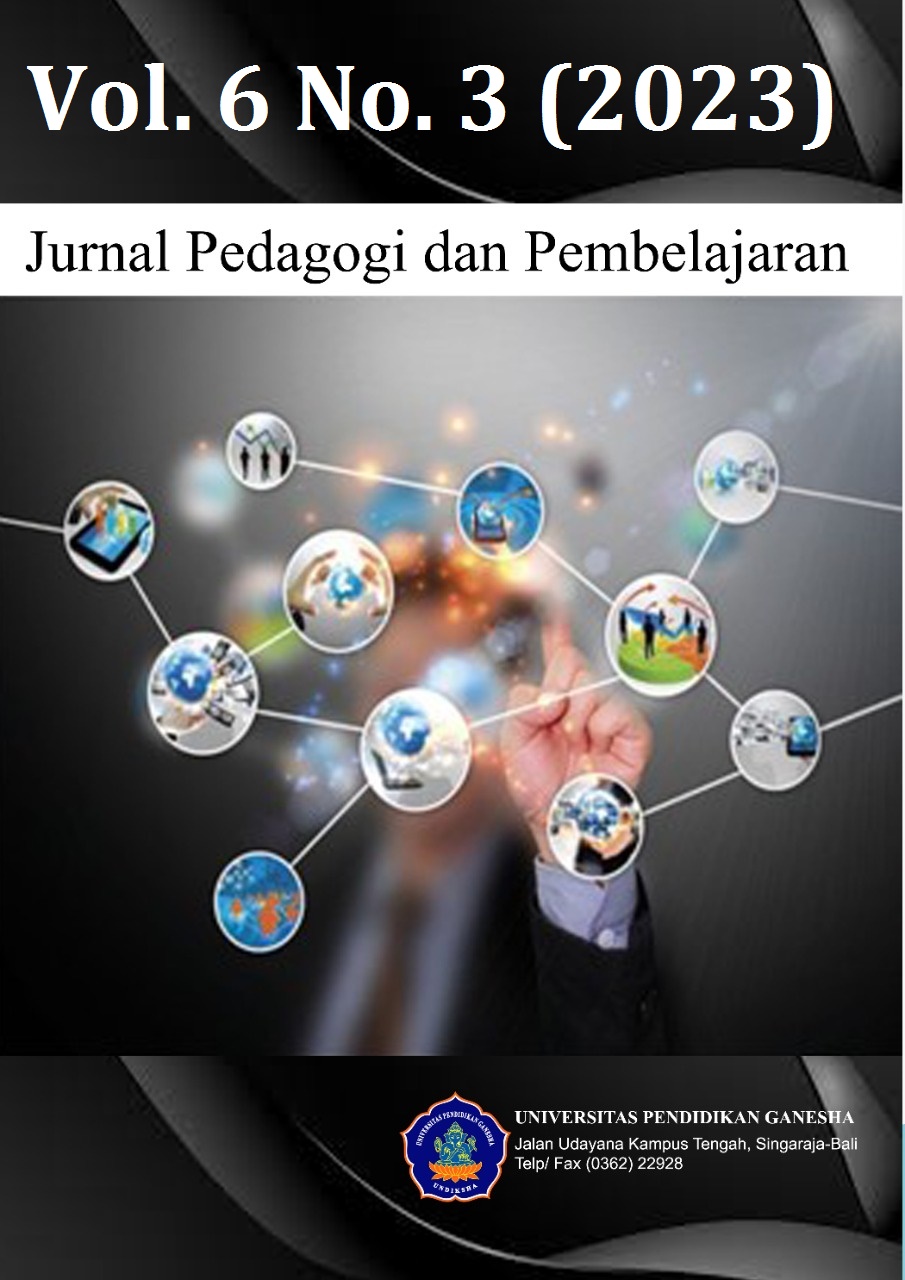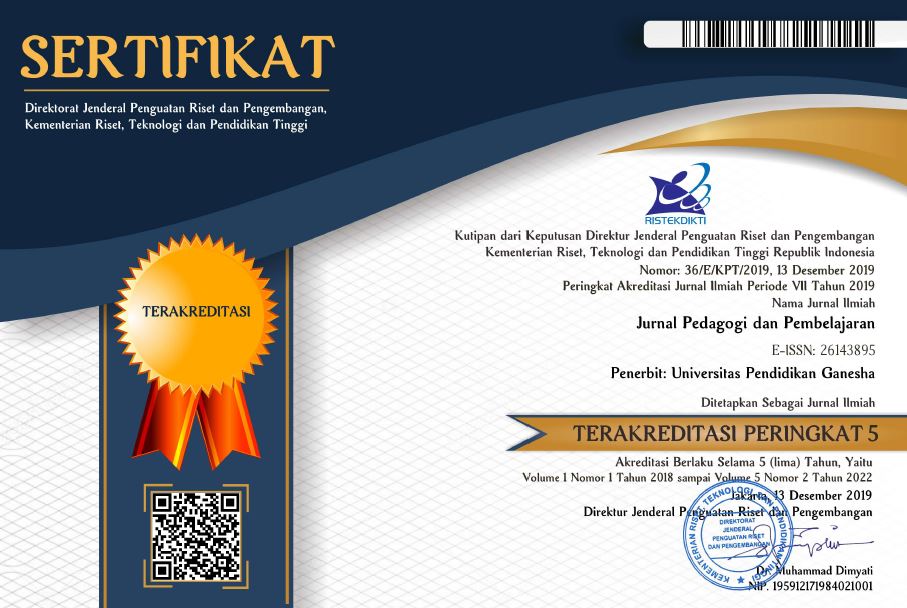Blended Learning to Improve Vocational Life Skills in Making Batik for Disabilities
DOI:
https://doi.org/10.23887/jp2.v6i3.64400Keywords:
Blended Learning, Vocational Life Skills, DisabilityAbstract
The learning strategies applied by educators are still conventional, including learning vocational skills. This research aims to examine the effect of blended learning on improving the vocational life skills of students with disabilities. This research is pre-experimental. This research design is a group pre-test-post-test design. The research subjects were students with disabilities at the Special High School (SMLAB). Data collection uses performance tests. Data analysis used the Wilcoxon signed-rank test (matched pairs test). The research results show that the vocational life skills of students with disabilities after learning with blended learning have improved more than before learning with blended learning. Learning with blended learning has a better and more positive influence on the vocational life skills of students with disabilities. This research implies that blended learning can improve students' abilities, increasing learning outcomes. In the learning process, students are more active, constructive, communicative, able to follow technological developments, and participate to improve their divergent thinking skills and abilities, in this case, thinking abilities related to vocational skills.
References
Ahmaddien, Iskandar. Syarkani, Y. (2019). Statistika Terapan Dengan Sistem SPSS. ITB Press. DOI: https://doi.org/10.31237/osf.io/9s7vh
Aji, A. L. D., & Haryani, T. N. (2017). Diversitas dalam Dunia Kerja: Peluang dan Tantangan bagi Disabilitas. Spirit Publik: Jurnal Administrasi Publik, 12(2), 83. https://doi.org/10.20961/sp.v12i2.16246. DOI: https://doi.org/10.20961/sp.v12i2.16246
Alsalhi, N. R., Al-Qatawneh, S., Eltahir, M., & Aqel, K. (2021). Does blended learning improve the academic achievement of undergraduate students in the mathematics course?: A case study in higher education. EURASIA Journal of Mathematics, Science and Technology Education, 17(4). https://doi.org/10.29333/ejmste/10781. DOI: https://doi.org/10.29333/ejmste/10781
Arkhipova, M. V., Belova, E. E., Gavrikova, Y. A., Lyulyaeva, N. A., & Shapiro, E. D. (2018). Blended learning in teaching EFL to different age groups. Advances in Intelligent Systems and Computing, 622(3), 380–386. https://doi.org/10.1007/978-3-319- 75383-6_49. DOI: https://doi.org/10.1007/978-3-319-75383-6_49
Bakhtiar, A. M. (2022). Pengembangan Media Busy Book Untuk Materi Membilang Benda Anak Tunagrahita Ringan. DIDAKTIKA: Jurnal Pemikiran Pendidikan, 28(2), 103–108. https://doi.org/10.30587/didaktika.v28i2.3702. DOI: https://doi.org/10.30587/didaktika.v28i2.3702
Behjat, F., Yamini, M., & Bagheri, M. S. (n.d.). Blended learning: A ubiquitous learning environment for reading comprehension. International Journal of English Linguistics, 2(1), 97–104. https://doi.org/10.5539/ijel.v2n1p97. DOI: https://doi.org/10.5539/ijel.v2n1p97
Blaine, A. M. (2019). Interaction and presence in the virtual classroom: An analysis of the perceptions of students and teachers in online and blended advanced placement courses. Computers & Education, 132(1), 31–43. https://doi.org/10.1016/j.compedu.2019.01.004. DOI: https://doi.org/10.1016/j.compedu.2019.01.004
Borba, M. C., Askar, P., Engelbrecht, J., Gadanidis, G., Llinares, S., & Aguilar, M. S. (2016). Blended learning, e-learning and mobile learning in mathematics education. ZDM - Mathematics Education, 48(5), 589–610. https://doi.org/10.1007/s11858-016-0798-4. DOI: https://doi.org/10.1007/s11858-016-0798-4
Buchert, L. (2014). Learning needs and life skills for youth: An introduction. International Review of Education, 60(2), 163–176. https://doi.org/10.1007/s11159-014-9431-3. DOI: https://doi.org/10.1007/s11159-014-9431-3
Chaidam, O., & Poonputta, A. (2022). Learning Achievement Improvement of 1st Grade Students by Using Problem-Based Learning (PBL) on TPACK MODEL. Journal of Education and Learning, 11(2), 43. https://doi.org/10.5539/jel.v11n2p43 DOI: https://doi.org/10.5539/jel.v11n2p43
Chen, W. S., & Yao, A. Y. T. (2016). An empirical evaluation of critical factors influencing learner satisfaction in blended learning: A pilot study. Universal Journal of Educational Research, 4(7), 1667–1671. https://doi.org/10.13189/ujer.2016.040719. DOI: https://doi.org/10.13189/ujer.2016.040719
Dangwal, K. L. (2017). Blended learning: An innovative approach. Universal Journal of Educational Research, 5(1), 129–136. https://doi.org/10.13189/ujer.2017.050116. DOI: https://doi.org/10.13189/ujer.2017.050116
Diputera, A. M., Damanik, S. H., & Wahyuni, V. (2022). Evaluasi Kebijakan Pendidikan Karakter Profil Pelajar Pancasila dalam Kurikulum Prototipe untuk Pendidikan Anak Usia Dini. Jurnal Bunga Rampai Usia Emas, 8(1), 1. https://doi.org/10.24114/jbrue.v8i1.32650. DOI: https://doi.org/10.24114/jbrue.v8i1.32650
Elvira, & Delsiana. (2019). Canva Sebagai Media Pembelajaran Pada Mata Pelajaran Dasar Listrik Dan Elektronika. Jurnal Vokasional Teknik Elektronika dan Informatika, 7(2), 80–81. https://doi.org/10.24036/voteteknika.v7i2.104261. DOI: https://doi.org/10.24036/voteteknika.v7i2.104261
Garrison, D. R., & Vaughan, N. D. (2013). Institutional change and leadership associated with blended learning innovation: Two case studies. The Internet and Higher Education, 18(1), 24–28. https://doi.org/10.1016/j.iheduc.2012.09.001. DOI: https://doi.org/10.1016/j.iheduc.2012.09.001
Greer, D., Rowland, A. L., & Smith, S. J. (2014). Critical considerations for teaching students with disabilities in online environments. Teaching Exceptional Children, 46(5), 779–791. https://doi.org/10.1177/0040059914528105. DOI: https://doi.org/10.1177/0040059914528105
Hampf, F., & Woessmann, L. (2017). Vocational vs. general education and employment over the life cycle: New evidence from PIAAC. CESifo Economic Studies, 63(3), 255–269. https://doi.org/10.1093/cesifo/ifx012 DOI: https://doi.org/10.1093/cesifo/ifx012
Hrastinski, S. (2019). What do we mean by blended learning? TechTrends, 63(5), 564–569. https://doi.org/10.1007/s11528-019-00375-5. DOI: https://doi.org/10.1007/s11528-019-00375-5
Jin, S. (2014). Implementation of smartphone-based blended learning in an EFL undergraduate grammar course. Multimedia-Assisted Language Learning, 17(4), 11–37. https://doi.org/10.15702/mall.2014.17.4.11. DOI: https://doi.org/10.15702/mall.2014.17.4.11
Jung, C. S., Jeong, J. C., & Kim, S. N. (2019). Impact of vocational education and training on adult skills and employment: An applied multilevel analysis. International Journal of Educational Development, 66(2), 129–138. https://doi.org/10.1016/j.ijedudev.2018.09.007. DOI: https://doi.org/10.1016/j.ijedudev.2018.09.007
Kaban, R. H., Anzelina, D., Sinaga, R., & Silaban, P. J. (2021). Pengaruh Model Pembelajaran PAKEM terhadap Hasil Belajar Siswa di Sekolah Dasar. Jurnal Basicedu, 5(1), 102–109. https://doi.org/10.31004/basicedu.v5i1.574. DOI: https://doi.org/10.31004/basicedu.v5i1.574
Kazemi, R., Momeni, S., & Abolghasemi, A. (2014). The effectiveness of life skill training on self-esteem and communication skills of students with dyscalculia. Procedia-Social and Behavioral Sciences, 114(2), 863–866. https://doi.org/10.1016/j.sbspro.2013.12.798. DOI: https://doi.org/10.1016/j.sbspro.2013.12.798
Kızıl, A. Ş. (2014). Blended instruction for EFL learners: Engagement, learning and course satisfaction. Jaltcall Journal, 10(3), 175–188. https://doi.org/10.29140/jaltcall.v10n3.174. DOI: https://doi.org/10.29140/jaltcall.v10n3.174
Kurniawati, M., Santanapurba, H., & Kusumawati, E. (2019). Penerapan Blended Learning Menggunakan Model Flipped Classroom Berbantuan Google Classroom Dalam Pembelajaran Matematika Smp. EDU-MAT: Jurnal Pendidikan Matematika, 7(1), 8–19. https://doi.org/10.20527/edumat.v7i1.6827. DOI: https://doi.org/10.20527/edumat.v7i1.6827
Lia, N., Syamwil, R., & Widayani, S. (2017). Model Pembelajaran Keterampilan Vokasional Berbasis Potensi Lokal di SMA Wilayah Kalimantan. Journal of Vocational and Career Education, 2(2). https://doi.org/10.15294/jvce.v2i2.13836. DOI: https://doi.org/10.15294/jvce.v2i2.13836
Mahande, R. D., Susanto, A., & Surjono, H. D. (2017). The dynamics of mobile learning utilization in vocational education: Frame model perspective review. Turkish Online Journal of Educational Technology-TOJET, 16(4), 65–75.
Maimunah, & Cinantya, C. (2021). Pelatihan Implementasi Blended Learning di Taman Kanak-kanak pada Guru TK Negeri Pembina Banjarmasin Timur. Bubungan Tinggi : Jurnal Pengabdian Masyarakat, 3(3), 224–229.
Mane, F., & Corbella, T. (2017). Developing and running an establishment skills survey: Guide to anticipating and matching skills and jobs. Publications Office of the European Union, 5(1). https://doi.org/10.2816/413514.
Miyanti, I. N. (2021). Blended Learning Menggunakan Whatsapp Untuk Pembelajaran Anak Usia Dini. Jurnal PG-PAUD Trunojoyo : Jurnal Pendidikan Dan Pembelajaran Anak Usia Dini, 8(1). https://doi.org/10.21107/pgpaudtrunojoyo.8i1.9810. DOI: https://doi.org/10.21107/pgpaudtrunojoyo.v8i1.9810
Muawanah, E. I., & Muhid, A. (2021). Strategi Meningkatkan Motivasi Belajar Siswa Selama Pandemi Covid-19. Jurnal Ilmiah Bimbingan Konseling Undiksha, 12(1), 90–98. https://doi.org/10.23887/JJBK.V12I1.31311. DOI: https://doi.org/10.23887/jjbk.v12i1.31311
Namaziandost, E., Neisi, L., & Momtaz, S. (n.d.). The effectiveness of flipped classroom model on listening comprehension among Iranian upper-intermediate EFL learners. Journal of Applied Linguistics and Language Research, 6(4), 129–139.
Nasheeda, A., Abdullah, H. B., Krauss, S. E., & Ahmed, N. B. (2019). A narrative systematic review of life skills education: Effectiveness, research gaps and priorities. International Journal of Adolescence and Youth, 24(3), 326–379. https://doi.org/10.1080/02673843.2018.1479278. DOI: https://doi.org/10.1080/02673843.2018.1479278
Ndlovu, M. C., & Mostert, I. (2018). Teacher perceptions of moodle and throughput in a blended learning programme for in-service secondary school mathematics teachers. Africa Education Review, 15(2), 131–151. https://doi.org/10.1080/18146627.2016.1241667. DOI: https://doi.org/10.1080/18146627.2016.1241667
Philipsen, B., Tondeur, J., Pareja Roblin, N., Vanslambrouck, S., & Zhu, C. (2019). Improving teacher professional development for online and blended learning: A systematic meta-aggregative review. Educational Technology Research and Development, 67(5), 1145–1174. https://doi.org/10.1007/s11423-019-09645-8. DOI: https://doi.org/10.1007/s11423-019-09645-8
Prasad, P., Maag, A., Redestowicz, M., & Hoe, L. S. (2018). Unfamiliar technology: Reaction of international students to blended learning. Computers & Education, 122(2), 92–103. https://doi.org/10.1016/j.compedu.2018.03.016. DOI: https://doi.org/10.1016/j.compedu.2018.03.016
Rafikayati, A., & Jauhari, M. N. (2021). Studi Tentang Pembelajaran Vokasional Bagi Anak Tunarungu Di SMPN 28 Surabaya. Special and Inclusive Education Journal (SPECIAL), 2(1), 77–83. https://doi.org/10.36456/special.vol2.no1.a3888. DOI: https://doi.org/10.36456/special.vol2.no1.a3888
Salmah, S., & Tamjidnoor. (2019). Aksesibilitas Pendidikan Bagi Kaum Disabilitas Pada Madrasah Ibtidaiyah Negeri (Min) Di Kota Banjarmasin. Al-Banjari: Jurnal Ilmiah Ilmu-Ilmu Keislaman, 18(1). https://doi.org/10.18592/al-banjari.v18i1.2995. DOI: https://doi.org/10.18592/al-banjari.v18i1.2995
Saputra, & Andrizal. (2018). Pengaruh Motivasi Terhadap Hasil Belajar Siswa SMK. Jurnal Inovasi Vokasional Dan Teknologi, 18(1), 25–33. https://doi.org/10.24036/invotek.v18i1.168.
Saputra, H. D., Ismet, F., & Andrizal, A. (2018). Pengaruh Motivasi Terhadap Hasil Belajar Siswa SMK. INVOTEK: Jurnal Inovasi Vokasional dan Teknologi, 18(1), 25–30. https://doi.org/10.24036/invotek.v18i1.168. DOI: https://doi.org/10.24036/invotek.v18i1.168
Satar, H. M., & Akcan, S. (2018). Pre-service EFL teachers’ online participation, interaction, and social presence. Language Learning and Technology, 22(1), 157–184.
Smith, K., & Hill, J. (2019). Defining the nature of blended learning through its depiction in current research. Higher Education Research & Development, 38(2), 383–397. https://doi.org/10.1080/07294360.2018.1517732. DOI: https://doi.org/10.1080/07294360.2018.1517732
Surjono, H. D., Muhtadi, A., & Wahyuningsih, D. (2017). The implementation of blended learning in multimedia courses for undergraduate students in Indonesia. International Journal of Information and Education Technology, 7(10), 783–786. https://doi.org/10.18178/ijiet.2017.7.10.972. DOI: https://doi.org/10.18178/ijiet.2017.7.10.972
Tang, C. M., & Chaw, L. Y. (n.d.). Digital literacy: A Prerequisite for effective learning in a blended learning environment? Electronic Journal of E-Learning, 14(1), 54–65.
Utomo, B. (2022). Analisis validitas isi butir soal sebagai salah satu upaya peningkatan kualitas pembelajaran di madrasah berbasis nilai-nilai islam. Jurnal Pendidikan Matematika (Kudus), 1(2). https://doi.org/10.21043/jmtk.v1i2.4868. DOI: https://doi.org/10.21043/jpm.v1i2.4883
Van Laer, S., & Elen, J. (2017). In search of attributes that support self-regulation in blended learning environments. Education and Information Technologies, 22(4), 1395–1454. https://doi.org/10.1007/s10639-016-9505-x. DOI: https://doi.org/10.1007/s10639-016-9505-x
Vanslambrouck, S., Zhu, C., Pynoo, B., Thomas, V., Lombaerts, K., & Tondeur, J. (2019). An in-depth analysis of adult students in blended environments: Do they regulate their learning in an ‘old school’way? Computers & Education, 128(3), 75–87. https://doi.org/10.1016/j.compedu.2018.09.008. DOI: https://doi.org/10.1016/j.compedu.2018.09.008
Wulandari, I. G. A. A. M., Sudatha, I. G. W., & Simamora, A. H. (2020). Pengembangan Pembelajaran Blended Pada Mata Kuliah Ahara Yoga Semester II di IHDN Denpasar. Jurnal Edutech Undiksha, 8(1), 1. https://doi.org/10.23887/jeu.v8i1.26459. DOI: https://doi.org/10.23887/jeu.v8i1.26459
Yu, W., & Du, X. (2019). Implementation of a blended learning model in content-based EFL curriculum. International Journal of Emerging Technologies in Learning (Online), 14(5), 188–199. https://doi.org/10.3991/ijet.v14i05.8546. DOI: https://doi.org/10.3991/ijet.v14i05.8546
Zavaraki, E. Z., & Schneider, D. (2017). Blended learning approach for students with spe- cial educational needs: A systematic review. Journal of Education & Social Policy, 6(3), 75–86. https://doi.org/10.30845/jesp.v6n3p12. DOI: https://doi.org/10.30845/jesp.v6n3p12
Zwart, D. P., Van Luit, J. E., Noroozi, O., & Goei, S. L. (2017). The effects of digital learning material on students’ mathematics learning in vocational education. Cogent Education, 4(1). https://doi.org/10.1080/2331186X.2017.1313581. DOI: https://doi.org/10.1080/2331186X.2017.1313581
Downloads
Published
How to Cite
Issue
Section
License
Copyright (c) 2023 wiwik widajati, SITI MAHMUDAH

This work is licensed under a Creative Commons Attribution-ShareAlike 4.0 International License.
Authors who publish with Jurnal Pedagogi dan Pembelajaran agree to the following terms:- Authors retain copyright and grant the journal the right of first publication with the work simultaneously licensed under a Creative Commons Attribution License (CC BY-SA 4.0) that allows others to share the work with an acknowledgment of the work's authorship and initial publication in this journal
- Authors are able to enter into separate, additional contractual arrangements for the non-exclusive distribution of the journal's published version of the work (e.g., post it to an institutional repository or publish it in a book), with an acknowledgment of its initial publication in this journal.
- Authors are permitted and encouraged to post their work online (e.g., in institutional repositories or on their website) prior to and during the submission process, as it can lead to productive exchanges, as well as earlier and greater citation of published work. (See The Effect of Open Access)













